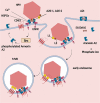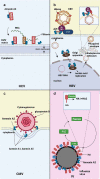Annexin A2: the missing piece in the puzzle of pathogen-induced damage
- PMID: 37482693
- PMCID: PMC10367575
- DOI: 10.1080/21505594.2023.2237222
Annexin A2: the missing piece in the puzzle of pathogen-induced damage
Abstract
Annexin A2 is a Ca2+ regulated protein belonging to the Annexin family and is found in the cytoplasm and cell membrane. It can exist in a monomeric form or in a heterotetrameric form with the S100A10 dimer. The research on Annexin A2 in tumours is currently active, and studies on its role in pathogen infection are increasing. Annexin A2 plays a crucial role in the life cycle of viruses by mediating adhesion, internalization, uncoating, transport, and release. In the case of parasites, bacteria, mycoplasma, fungi, and other pathogens, Annexin A2 binds to the ligand on the pathogen, which mediates the pathogen's adhesion to the host cell, ultimately leading to infection and damage to the host. Furthermore, some studies have developed biological or chemical drugs that target Annexin A2, which have demonstrated promising anti-infective effects. Thus, targeting Annexin A2 may present a promising therapeutic approach for the treatment of diverse infectious diseases. In summary, this paper provides an overview of Annexin A2 and its role in various pathogens. It highlights its regulation of pathogen infection and its potential as a therapeutic target for the treatment of infectious diseases.
Keywords: A2t; Annexin A2; S100A10; ligand; pathogen; therapeutic target.
Conflict of interest statement
No potential conflict of interest was reported by the author(s).
Figures



Similar articles
-
Annexin A2 Mediates the Localization of Measles Virus Matrix Protein at the Plasma Membrane.J Virol. 2018 Apr 27;92(10):e00181-18. doi: 10.1128/JVI.00181-18. Print 2018 May 15. J Virol. 2018. PMID: 29491166 Free PMC article.
-
The p11/S100A10 light chain of annexin A2 is dispensable for annexin A2 association to endosomes and functions in endosomal transport.PLoS One. 2007 Oct 31;2(10):e1118. doi: 10.1371/journal.pone.0001118. PLoS One. 2007. PMID: 17971878 Free PMC article.
-
Regulation of CFTR function by annexin A2-S100A10 complex in health and disease.Gen Physiol Biophys. 2009;28 Spec No Focus:F14-9. Gen Physiol Biophys. 2009. PMID: 20093721 Review.
-
The Annexin A2/S100A10 Complex: The Mutualistic Symbiosis of Two Distinct Proteins.Biomolecules. 2021 Dec 9;11(12):1849. doi: 10.3390/biom11121849. Biomolecules. 2021. PMID: 34944495 Free PMC article. Review.
-
S100A10/p11: family, friends and functions.Pflugers Arch. 2008 Jan;455(4):575-82. doi: 10.1007/s00424-007-0313-4. Epub 2007 Jul 19. Pflugers Arch. 2008. PMID: 17638009 Review.
Cited by
-
Knockdown of annexin A2 enhances the host cell apoptosis induced by Eimeria tenella.Front Vet Sci. 2025 Jul 24;12:1595384. doi: 10.3389/fvets.2025.1595384. eCollection 2025. Front Vet Sci. 2025. PMID: 40777830 Free PMC article.
-
The mechanistic role of natural antimicrobials in preventing Staphylococcus aureus invasion of MAC-T cells using an in vitro mastitis model.Ir Vet J. 2024 Feb 27;77(1):3. doi: 10.1186/s13620-024-00265-0. Ir Vet J. 2024. PMID: 38414081 Free PMC article.
-
Antiphospholipid Antibodies as Key Players in Systemic Lupus Erythematosus: The Relationship with Cytokines and Immune Dysregulation.Int J Mol Sci. 2024 Oct 20;25(20):11281. doi: 10.3390/ijms252011281. Int J Mol Sci. 2024. PMID: 39457063 Free PMC article. Review.
-
Annexin A2: A Double-Edged Sword in Pathogen Infection.Pathogens. 2024 Jul 4;13(7):564. doi: 10.3390/pathogens13070564. Pathogens. 2024. PMID: 39057791 Free PMC article. Review.
-
Endothelial histone deacetylase 9 promotes diabetic retinopathy in mice by regulating endothelial-mesenchymal transition.Acta Pharmacol Sin. 2025 Aug;46(8):2213-2224. doi: 10.1038/s41401-025-01523-9. Epub 2025 Mar 31. Acta Pharmacol Sin. 2025. PMID: 40164754
References
Publication types
MeSH terms
Substances
LinkOut - more resources
Full Text Sources
Medical
Miscellaneous
